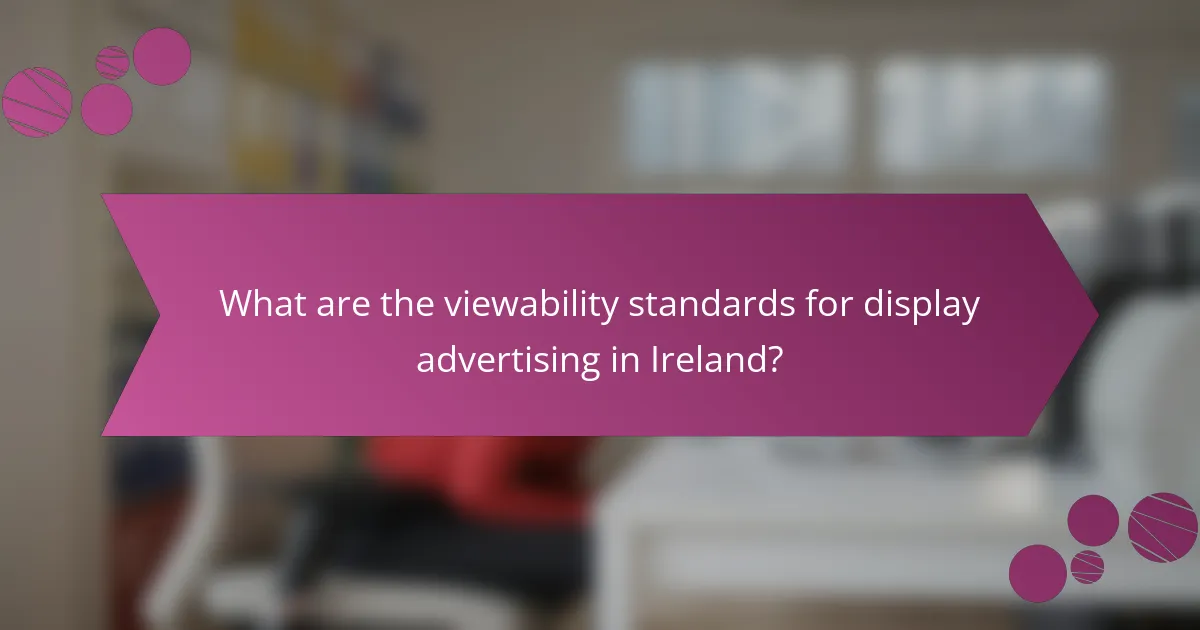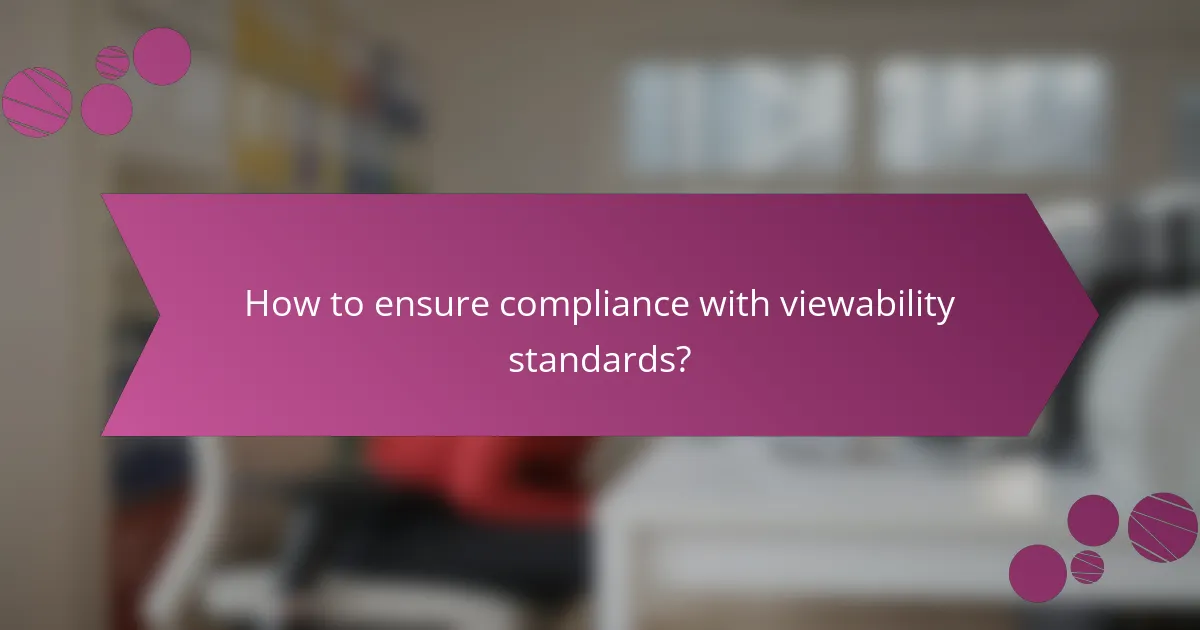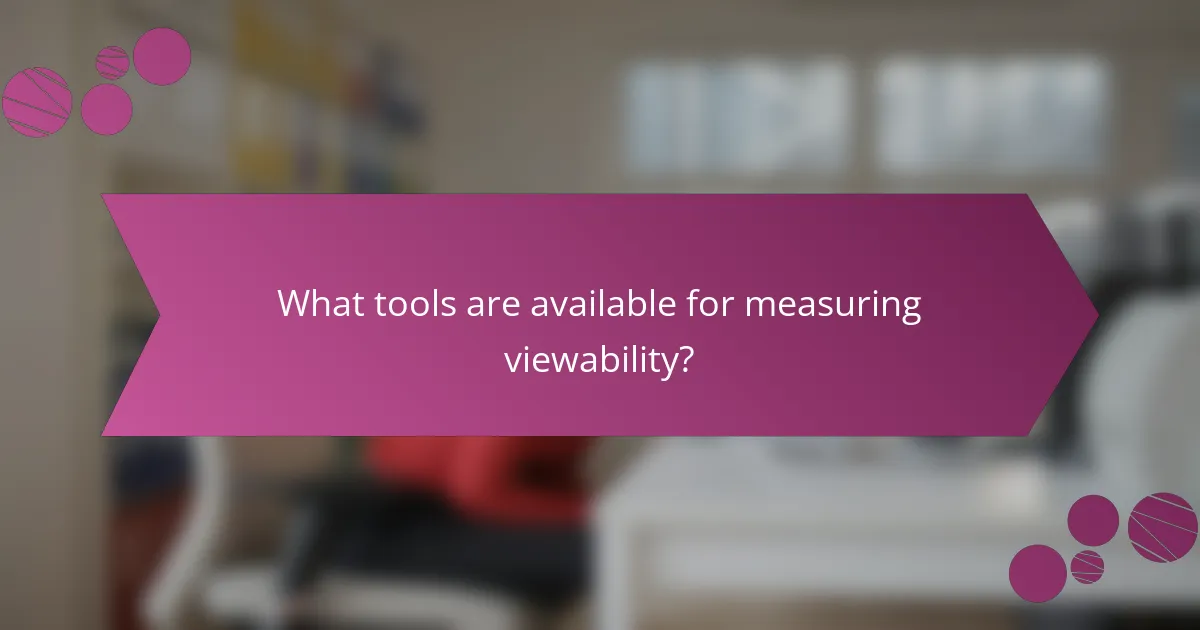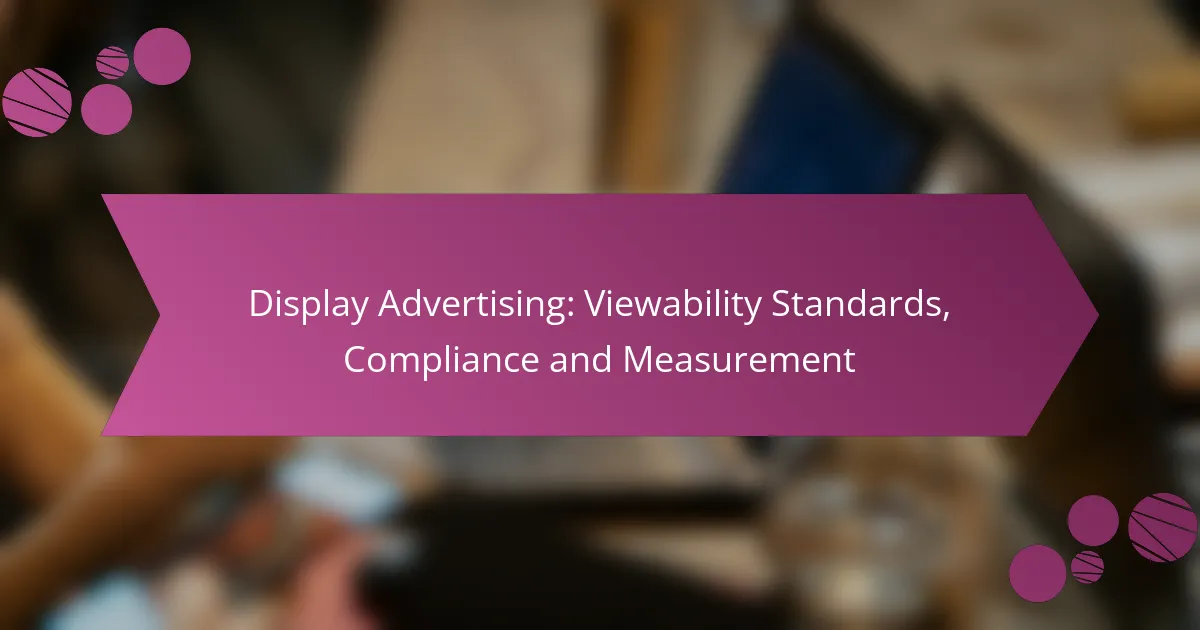Display advertising in Ireland is guided by strict viewability standards set by industry organizations, which ensure that ads are effectively seen by users. Compliance with these standards requires advertisers to adopt robust measurement practices and verification tools to assess ad visibility and engagement accurately.

What are the viewability standards for display advertising in Ireland?
In Ireland, viewability standards for display advertising are primarily governed by guidelines set by industry organizations, ensuring that ads are seen by users. These standards focus on metrics that determine whether an ad is considered viewable based on its visibility and duration on the screen.
Interactive Advertising Bureau (IAB) guidelines
The Interactive Advertising Bureau (IAB) provides essential guidelines for measuring viewability in display advertising. According to IAB standards, an ad is deemed viewable if at least 50% of its pixels are in view on the screen for a minimum of one second for display ads and two seconds for video ads.
Advertisers and publishers in Ireland should adhere to these guidelines to ensure compliance and maximize the effectiveness of their campaigns. Regular audits and adherence to IAB recommendations can enhance ad performance and accountability.
Media Rating Council (MRC) standards
The Media Rating Council (MRC) has established standards that align closely with IAB guidelines but offer additional clarity on measurement practices. MRC standards stipulate that viewable impressions must be counted only when the ad meets the visibility criteria outlined by the IAB.
Compliance with MRC standards is crucial for advertisers seeking to validate their ad metrics. It ensures that the reported viewability rates are credible and can be trusted by stakeholders within the advertising ecosystem.
Viewable impressions definition
Viewable impressions refer to the instances when an ad is considered viewable based on established criteria. Specifically, this means that the ad must be displayed on the user’s screen for the required duration and meet the pixel visibility threshold.
Understanding viewable impressions is vital for optimizing advertising strategies. Advertisers should focus on improving their viewability rates by selecting high-quality placements and monitoring performance metrics regularly to ensure that their ads are effectively reaching their target audience.

How to ensure compliance with viewability standards?
To ensure compliance with viewability standards, advertisers must implement effective measurement practices and utilize verification tools. This involves understanding the metrics that define viewability and regularly assessing ad placements against these benchmarks.
Implementing ad verification tools
Ad verification tools are essential for measuring whether ads meet viewability standards. These tools track metrics such as the percentage of an ad that is in view and the duration it remains visible. Popular options include Integral Ad Science, Moat, and DoubleVerify.
When selecting an ad verification tool, consider factors like integration capabilities, reporting features, and the specific viewability standards they support. Ensure the tool aligns with industry standards such as the Interactive Advertising Bureau (IAB) guidelines, which typically require at least 50% of an ad to be in view for a minimum of one second.
Regular audits and reporting
Conducting regular audits is crucial for maintaining compliance with viewability standards. These audits should assess ad placements, viewability rates, and overall campaign performance. Aim for audits on a monthly or quarterly basis to identify trends and areas for improvement.
Reporting should be clear and actionable, highlighting key metrics such as viewability rates and any discrepancies from set standards. Use these reports to inform adjustments in ad strategies, ensuring that campaigns consistently meet or exceed viewability benchmarks.

What measurement techniques are used for viewability?
Viewability measurement techniques assess whether an ad is actually seen by users. These methods help advertisers ensure their campaigns are effective by providing insights into ad visibility and engagement.
Third-party measurement solutions
Third-party measurement solutions are independent tools that verify ad viewability across various platforms. These services, such as Moat and Integral Ad Science, use tracking pixels and tags to collect data on ad impressions and user interactions.
When selecting a third-party solution, consider factors like integration capabilities, reporting features, and compliance with industry standards such as the Interactive Advertising Bureau (IAB) guidelines. These solutions often provide detailed analytics that can help optimize ad placements.
In-house analytics platforms
In-house analytics platforms allow companies to measure viewability using their own data and technology. These systems can be tailored to specific business needs, offering customized reporting and insights into user behavior.
While in-house solutions can provide more control and potentially lower costs, they require significant resources to develop and maintain. Companies should weigh the benefits of customization against the investment in technology and expertise needed to implement effective measurement strategies.

What are the challenges in measuring viewability?
Measuring viewability presents several challenges, primarily due to technological limitations and varying standards. Factors such as ad blocking, cross-device tracking, and differing definitions of what constitutes a viewable impression complicate accurate measurement.
Ad blocking software impact
Ad blocking software significantly affects viewability metrics by preventing ads from being displayed at all. This means that a substantial portion of potential impressions may not be counted, leading to skewed data on ad effectiveness. Advertisers must consider that a significant percentage of users, particularly younger demographics, actively use ad blockers.
To mitigate this issue, advertisers can focus on creating high-quality, non-intrusive ads that encourage users to disable their ad blockers. Engaging content and clear value propositions can help in gaining user trust and increasing overall viewability.
Cross-device measurement difficulties
Cross-device measurement poses a challenge because users often interact with ads across multiple devices, making it difficult to track viewability consistently. Different devices may have varying screen sizes and resolutions, which can affect how ads are displayed and perceived. This inconsistency complicates the aggregation of viewability data across platforms.
To address these difficulties, advertisers should implement unified tracking solutions that can follow user behavior across devices. Utilizing tools that provide cross-device analytics can help in obtaining a clearer picture of ad performance and viewability rates.

How does viewability affect advertising performance?
Viewability significantly impacts advertising performance by determining whether an ad is actually seen by users. Higher viewability rates typically lead to improved engagement metrics, as ads that are visible are more likely to capture attention and drive actions.
Impact on click-through rates
Click-through rates (CTR) are directly influenced by viewability. Ads that are fully visible for a sufficient amount of time tend to have higher CTRs compared to those that are not. For instance, a well-placed banner ad with a viewability rate above 70% can see CTRs that are several times higher than ads with lower visibility.
To optimize CTR, advertisers should focus on placements that enhance viewability, such as above-the-fold positions on websites. Regularly monitoring viewability metrics can help identify underperforming ads that may need repositioning or redesigning.
Correlation with conversion rates
Conversion rates also show a strong correlation with viewability. Ads that achieve high visibility not only attract clicks but also lead to increased conversions, as users are more likely to engage with content they can see clearly. Studies suggest that improving viewability can boost conversion rates by significant margins, often in the range of 20-50%.
To maximize conversion rates, advertisers should ensure that their ads are not only visible but also relevant to the audience. Using A/B testing to compare different ad formats and placements can provide insights into which strategies yield the best results in terms of visibility and conversions.

What are the best practices for improving viewability?
Improving viewability in display advertising involves strategic placement and engaging formats. By optimizing where and how ads appear, advertisers can significantly increase the likelihood that users will see and interact with their ads.
Optimizing ad placement
Effective ad placement is crucial for enhancing viewability. Position ads above the fold, where users are more likely to see them without scrolling. Aim for placements that are integrated within content rather than on the edges of a page, as this can lead to higher engagement rates.
Consider using heat maps and analytics tools to identify high-traffic areas on your website. Testing different placements can also help determine which locations yield the best results. Avoid cluttered areas where ads may compete for attention, as this can diminish their visibility.
Using engaging ad formats
Utilizing engaging ad formats can significantly boost viewability. Formats such as video ads, interactive banners, and rich media tend to capture user attention more effectively than static images. These formats encourage interaction, which can lead to higher engagement rates.
When selecting ad formats, consider the target audience and the context in which the ads will appear. For instance, mobile users may respond better to vertical video ads, while desktop users might prefer larger, more visually appealing banners. Always ensure that the ad formats are optimized for various devices to maximize reach.

What tools are available for measuring viewability?
Several tools are available for measuring viewability in display advertising, focusing on how effectively ads are seen by users. These tools help advertisers assess compliance with industry standards and optimize their campaigns for better performance.
Third-party measurement solutions
Third-party measurement solutions are independent platforms that provide viewability metrics across various ad networks. These tools, such as Moat, DoubleVerify, and Integral Ad Science, track whether ads are in view and for how long. They offer comprehensive reports that help advertisers understand their ad visibility and effectiveness.
Using third-party tools can enhance credibility, as they provide unbiased data. Advertisers should ensure that the chosen solution is compliant with industry standards like the Media Rating Council (MRC) guidelines, which define viewability metrics.
In-house analytics tools
In-house analytics tools are developed by advertisers or agencies to measure viewability directly within their ad platforms. These tools can integrate with existing systems, allowing for real-time tracking and reporting of ad performance. While they offer customization, they may lack the independent verification that third-party tools provide.
When using in-house solutions, it’s crucial to align metrics with industry standards to ensure accuracy. Regular audits and updates can help maintain the reliability of the data collected.
Browser extensions and plugins
Browser extensions and plugins can provide quick insights into ad viewability while browsing. Tools like Ghostery and Adblock Plus offer features that allow users to see which ads are viewable and track their performance. However, these tools are typically more suited for individual users rather than comprehensive campaign analysis.
Advertisers can leverage these tools for preliminary checks but should rely on more robust solutions for detailed reporting. They can be useful for understanding user experience and identifying potential issues with ad placements.









